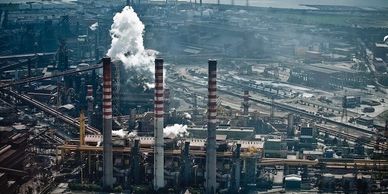We are working hard to make Taranto a better place..
Taranto features the largest steel plant in Europe: ILVA
The factory was built in Taranto, an ancient city founded by the Greeks, in the early 1960s, after being rejected by Bari, capital of the Puglia region, and nearby Lecce. Acres of farmland and thousands of olive trees were destroyed to make way for the sprawling complex, which is almost three times the size of Taranto itself.For the first few decades, the factory brought prosperity to a city that previously survived on fishing and agriculture. Workers flocked from neighbouring areas or returned home from overseas to take jobs there. At its peak, the plant produced more than 10m tonnes of steel a year, with a workforce of more than 20,000.
ILVA causes thousands of premature deaths every year

Pollution from the red-and-white-striped chimneys that loom over the city became an accepted part of life. Some former workers recall blowing black mucus from their nose. Children played with the dust, some finding it on their pillows in the morning when windows were left open in summer. “It was like glitter,” said Ignazio D’Andria, the owner of Mini Bar in Tamburi. “We thought it was a gift from the fairies, when really it was poison.”
The emissions – a mix of minerals, metals and carcinogenic dioxins – infiltrated the sea, all but destroying another of the city’s economic lifelines – mussel fishing.
The emissions: a mix of minerals, metals and carcinogenic dioxins

Cancer cases climbed, but it wasn’t until 2012 that official figures showed the death rate from the disease in the area was 15% above the national average. More recent studies confirmed a link between the emissions and the prevalence of cancer as well as higher-than-average rate of respiratory, kidney and cardiovascular illnesses.A report by Sentieri, an epidemiological monitoring group, found that between 2005 and 2012, 3,000 deaths were directly linked to “limited environmental exposure to pollutants”. Medics say the cancer rate fluctuates in line with the factory’s output.Children have been acutely affected: a 2019 study by Italy’s higher health institute, ISS, found that in the seven years to 2012 there was almost twice the rate of childhood lymphoma in Taranto than regional averages, and a more recent study by Sentieri showed an excess of childhood cancer in the city compared with the rest of Puglia.In January, local medical professionals appealed to the government to prioritise health in its dealings with the factory owners, and seize the opportunity to finally clean up the ailing complex.
Waste treatment Plant

Taranto also hosts a waste treatment plant, built in the 80's by the Fasano Group of Companies
ENI oil refinery

As well as an oil refinery. untill few years ago, we also had a cement factory...
Green Italy: Environmental Planning and Management
Our team has been actively involved in designing and building pollution control systems as well as comprehensive environmental planning and management services to help develop and implement sustainable practices that reduce environmental impact and promote social responsibility.